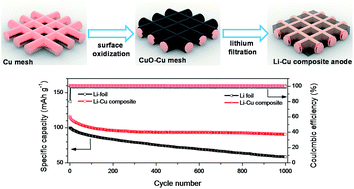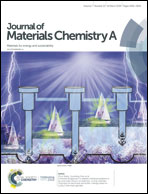Lithiophilicity conversion of the Cu surface through facile thermal oxidation: boosting a stable Li–Cu composite anode through melt infusion†
Abstract
Introducing porous conductive matrixes as a “host” for metallic lithium (Li) can restrain the growth of Li dendrites and accommodate the volume fluctuation during cycling. These two key factors severely impede the practical application of metallic Li anodes. However, uniformly pre-loading Li into such matrixes remains a great challenge. Herein, a facile thermal oxidation approach was employed to modify the surface of a Cu mesh from being lithiophobic to being lithiophilic. In particular, the Cu mesh was uniformly coated with a layer of CuO after thermal treatment and thus it became lithiophilic due to the strong interaction between CuO and molten Li. Through a melt infusion approach, metallic Li was homogeneously pre-loaded into the Cu mesh which could simultaneously induce a homogeneous distribution of the electrical field and accommodate the volume fluctuation of metallic Li during cycling. As a result, the Li–Cu composite anode demonstrated a stable cycling performance in a symmetric cell (1000 cycles at a current density of 10 mA cm−2) and a full cell paired with Li iron phosphate (90.8 mA h g−1 at 5C after 1000 cycles, 77.6% of initial capacity). Such a facile and cost effective approach provides a solution for the mass production of stable Li anodes with emphasis on lithiophilicity conversion of the surface of Cu.



 Please wait while we load your content...
Please wait while we load your content...